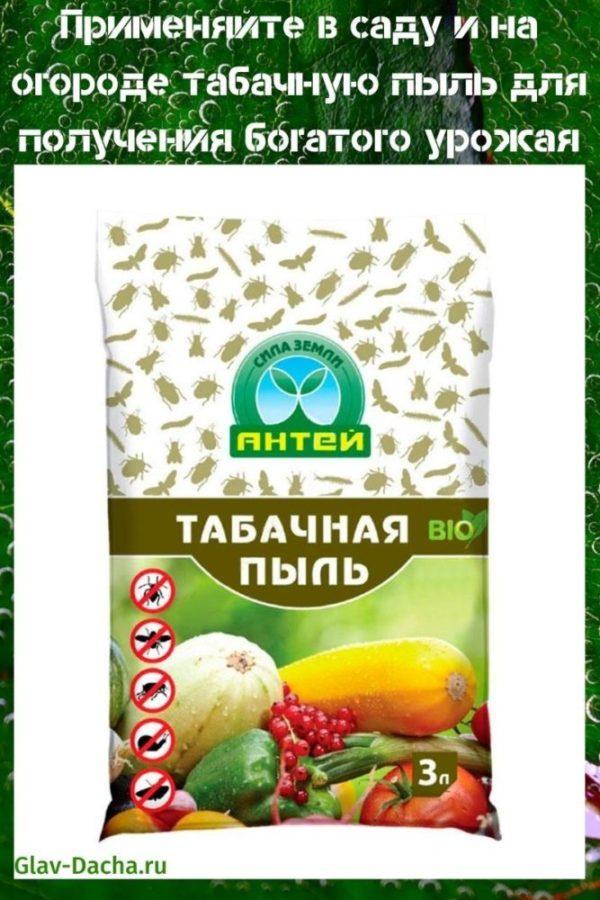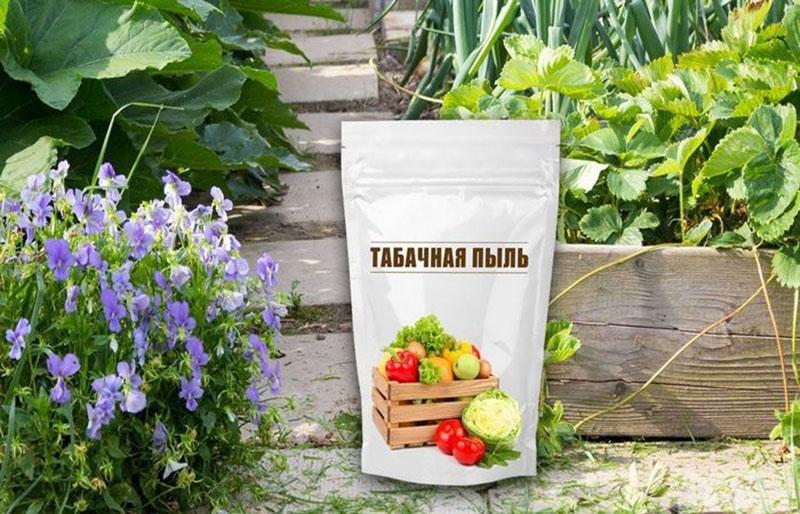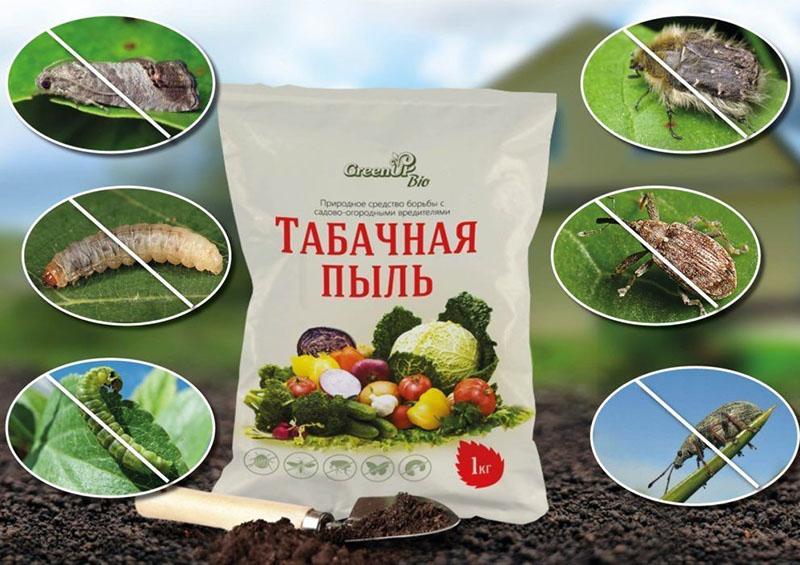Use tobacco dust in the garden and in the garden for a rich harvest
 Tobacco dust is a natural remedy that is widely used in horticulture and horticulture as an effective insect pest control and organic fertilizer. This substance does not harm the ecosystem of the garden plot, as well as fertile soil and helps to grow a rich harvest without the use of chemicals.
Tobacco dust is a natural remedy that is widely used in horticulture and horticulture as an effective insect pest control and organic fertilizer. This substance does not harm the ecosystem of the garden plot, as well as fertile soil and helps to grow a rich harvest without the use of chemicals.
What is tobacco dust

The substance is available in the form of a free-flowing powder, packaged in plastic or paper bags of 260 g and 1 kg. Tobacco dust is produced separately in the form of a smoke bomb intended for fumigation of crop storage barns, greenhouses and greenhouses.
How is tobacco dust taken in gardening
 The use of tobacco dust in gardening can vary. It is used as a natural, organic fertilizer, which is introduced into the soil at the same time as digging. The dust contains a large amount of nutrients, which can increase yields by 35-40%.
The use of tobacco dust in gardening can vary. It is used as a natural, organic fertilizer, which is introduced into the soil at the same time as digging. The dust contains a large amount of nutrients, which can increase yields by 35-40%.
Tobacco dust is often used as a natural and highly effective insecticide that protects vegetable, fruit, ornamental crops, as well as fruit bushes from thrips, flea beetles, aphids and other pests.
Tobacco dust can be used alone or mixed with other means - most often soda, makhorka, ash, lime.
Use as fertilizer
 Tobacco as a fertilizer not only helps to increase the productivity of garden crops, but also to increase the biological activity of the soil, while increasing the quality of ripe fruits.
Tobacco as a fertilizer not only helps to increase the productivity of garden crops, but also to increase the biological activity of the soil, while increasing the quality of ripe fruits.
There are several ways to use tobacco dust to fertilize plants.:
- Pour tobacco directly into the soil during digging at the rate of 3-4 g per 1 m².
- Apply the nutrient to the bottom of the holes when planting fruit trees, shrubs and flowers - about 500-600 g each.
- For autumn application, you can mix tobacco dust with phosphorus or potassium preparations.
- In spring, tobacco is applied simultaneously with nitrogenous fertilizers.
- The natural remedy can also be used when growing a lawn - before sowing it, spread the tobacco over the surface of the soil, loosen it and water it.
Tobacco can be used as a nutritious organic fertilizer for ornamental plants. Tobacco ash for flowers not only ensures their full growth and active flowering, but also prevents the appearance of pests.
To do this, put a bucket of earth on a thick plastic wrap or oilcloth, spread a teaspoon of tobacco dust on top with your hands and use this substrate for planting plants.
Application against pests
 Pest tobacco dust is a natural insecticidal substance. It is used in various ways - for dusting, fumigating and dusting plants, preparing broths and infusions.
Pest tobacco dust is a natural insecticidal substance. It is used in various ways - for dusting, fumigating and dusting plants, preparing broths and infusions.
Tobacco dust products help get rid of various insect pests, which include:
- fleas;
- cabbage and onion fly;
- leaf roll;
- honeydew;
- aphid;
- spider mite;
- thrips.
In addition, tobacco dust helps to clear the backyard of caterpillars, ants, mucus, moths, leaf gnats and gooseberry moths.
Dusting with tobacco dust
 The use of tobacco dust against pests is often carried out by dusting (dusting) the plants. To do this, you can use both tobacco and its mixture with lime or ash. All components must be taken in equal parts.
The use of tobacco dust against pests is often carried out by dusting (dusting) the plants. To do this, you can use both tobacco and its mixture with lime or ash. All components must be taken in equal parts.
Dusting can be carried out both for plants in open soil and in greenhouses. Substance consumption - 15-20 g per 1 m². Such processing should be carried out no more than 1-2 times throughout the season with an interval of 15 days. If it starts raining at this time, re-treatment is carried out regardless of how much time has passed since the first dusting.
In dry, calm weather, manually dust all ground parts of plants and the soil around them with tobacco dust. For a more even dusting, you can use a fine sieve - this will provide a thin coating.
The dusting method is excellent for treating any low-growing crops, as well as for young shoots and seedlings, both in the greenhouse and in the open field.
Decoction of tobacco dust
 The use of tobacco dust in the form of a decoction is easy and simple - that is why this method of processing garden plants is the most popular.
The use of tobacco dust in the form of a decoction is easy and simple - that is why this method of processing garden plants is the most popular.
Decoction preparation:
- Mix 500 g of tobacco dust with 10 liters of water, place over low heat.
- Bring the broth to a boil and simmer for 25-35 minutes. As it boils, the liquid boils away - add it to its original volume.
- Leave the infusion to infuse for a day, then strain.
- Dilute the product with clean water in a 1: 3 ratio.
- Before processing, add 2 tablespoons of shampoo, grated laundry or liquid soap to a bucket with a decoction of tobacco dust. Thanks to this, the tobacco broth will adhere better and faster to the leaves and stems of plants.
 A decoction of tobacco dust can be used to combat leaf-eating caterpillars in the garden. To do this, when boiling the broth, add onion peels to it.
A decoction of tobacco dust can be used to combat leaf-eating caterpillars in the garden. To do this, when boiling the broth, add onion peels to it.
Spraying is carried out with the obligatory use of protective clothing and a respirator, in dry and calm weather, preferably in the early morning or late evening. The effectiveness of the tobacco broth lasts up to 2 weeks. In case of rain or strong wind, the decoction of the plants must be repeated.
Tobacco infusion
 Spray tobacco infusion is used to treat plants from harmful insects. Spraying is carried out twice a season, the last treatment is no later than 15 days before harvesting.
Spray tobacco infusion is used to treat plants from harmful insects. Spraying is carried out twice a season, the last treatment is no later than 15 days before harvesting.
 To prepare tobacco infusion, pour 100 g of tobacco dust with 10 liters of hot water. Leave to infuse for 48 hours. After that, strain the infusion and prepare in the same way as the broth. Dilute with clean water and add soap or shampoo.
To prepare tobacco infusion, pour 100 g of tobacco dust with 10 liters of hot water. Leave to infuse for 48 hours. After that, strain the infusion and prepare in the same way as the broth. Dilute with clean water and add soap or shampoo.
When spraying trees with tobacco infusion or broth, especially carefully treat all kinks, cracks and chips on the bark. This is where insect eggs are most often found.
Fumigation
 Tobacco dust can be fumigated to kill insect pests. Plant processing is very simple. Set fire to the collected foliage, and when the fire is sufficiently lit, add tobacco dust to it.
Tobacco dust can be fumigated to kill insect pests. Plant processing is very simple. Set fire to the collected foliage, and when the fire is sufficiently lit, add tobacco dust to it.
You can also make your own cigarette lighter. To do this, place a tin can on bricks in the shade under a tree. Pour hot coals into the bottom of the container, and small portions of tobacco dust on top.
To process 50 m², you will need up to 1-2 kg of tobacco. The duration of fumigation should be at least 30-45 minutes. The procedure is best done in dry and calm weather. The smoke from the tobacco will rise evenly and evenly, enveloping the entire crown and branches.
 This method is best for treating fruit trees and shrubs, and pest control in greenhouses. Fumigation should only be done 15 days before flowering.Otherwise, the bees will not pollinate the trees. Soil processing in the greenhouse is carried out 3-4 days before the start of the first sowing work.
This method is best for treating fruit trees and shrubs, and pest control in greenhouses. Fumigation should only be done 15 days before flowering.Otherwise, the bees will not pollinate the trees. Soil processing in the greenhouse is carried out 3-4 days before the start of the first sowing work.
Precautions for use
 The use of tobacco in a summer cottage requires special care, since nicotine has a negative effect not only on insects, but also on the human body. It can cause severe allergic reactions or serious toxicity.
The use of tobacco in a summer cottage requires special care, since nicotine has a negative effect not only on insects, but also on the human body. It can cause severe allergic reactions or serious toxicity.
Therefore, working with tobacco is carried out in compliance with all safety measures:
- carry out processing of plants only in a respirator, and in its absence - using a cotton-gauze bandage;
- protect your eyes with glasses and your hands with thick gloves;
- be sure to hide your hair under a hat;
- try to hide as much as possible all open areas of the body with high collars, long sleeves;
- during the fumigation of greenhouses and greenhouses, you must not be inside.
 Tobacco dust is a multifunctional natural product that is widely used in horticulture and horticulture. This substance helps to saturate the fertile soil with nutrients. Provides full-fledged growth of horticultural crops and increased productivity. Tobacco effectively fights insect pests both in greenhouses and outdoors.
Tobacco dust is a multifunctional natural product that is widely used in horticulture and horticulture. This substance helps to saturate the fertile soil with nutrients. Provides full-fledged growth of horticultural crops and increased productivity. Tobacco effectively fights insect pests both in greenhouses and outdoors.